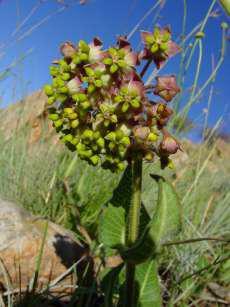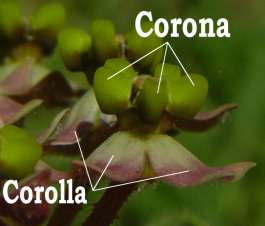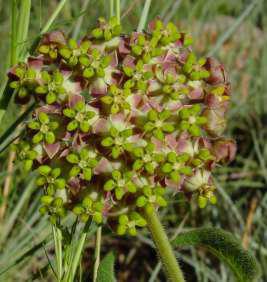Asclepias albens
Asclepias albens (E.Mey.) Schltr.
Family: Apocynaceae
Common names: cartwheels (Eng.); idoyi, ishongwe (Zulu); tshalale (Venda)
Introduction
This is the most widespread species of Asclepias in South Africa.

Description
Description
An erect or decumbent perennial herb. Leaves simple, ovate on short stalks with bristly hairs on both surfaces.

Inflorescence is a dense, many flowered umbel borne terminally. Flowers are mauvish green with a bright yellow corona and sweetly scented. Flowering time: October to March. Fruit ± 50mm long, with long, bumpy, fleshy ridges, tip beaked.

This widespread species of Asclepias is varied over its range and a number of distinct ecotypes can be observed. One of the most common forms occurs along the Natal coast. In this form plants are smaller, stems with few leaves broadly ovate and shorter, with longer peduncles. The form found along the Zululand coast is also distinct with shorter peduncles, narrow, lanceolate, hairy leaves and shorter stems. Plants in Natal Midlands have lanceolate leaves that are darker green than usual. However, up to now, no evidence has been found to support hydridization.
Conservation Status
Status
This herb is common and widespread. Even though it is not threatened, it grows in the grassland biome. This biome is at present heavily exploited in southern Africa for industrialization and residential developments.
Distribution and habitat
Distribution description
Southern African endemic. Occurs in grassland in Mpumalanga, KwaZulu-Natal, Eastern Cape and Swaziland, at an altitude of 10-1 700 m. It grows in grasslands prone to frequent burning- in some extreme cases where vegetation is burnt annually. It usually appears when grass is still short and where it receives full sunlight, often in rocky areas.

Derivation of name and historical aspects
History
Asclepias is dedicated to Asklepios, the Greek god of medicine. Asclepias are herbaceous perennials, scrambling or twining, often succulents with watery or milky sap. Inflorescence is generally an umbel with a central crown like corona. The corona is an outgrowth/appendage of the corolla.
Uses
Use
The young leaves are cooked as spinach or imifino.
Growing Asclepias albens
Grow
Asclepias are rarely cultivated other than in native plant gardens and natural areas. They are well adapted in these areas. In environments to their liking they often increase rapidly from self-sown seeds. When cultivated, they generally succeed in ordinary soils in full sun. Because of their deep roots, they do not transplant readily. The best results are had by raising plants from seeds or root cuttings and containing them in individual pots until they are planted.
References
- Evert Thomas, H. The New York Botanical Garden illustrated encyclopedia of horticulture, vol. 1. Garland Publishing, New York.
- Bailey, L.H. The standard cyclopedia of horticulture, vol. 1. MacMillan, New York.
- Leistner, O.A. (ed.) 2000. Seed plants of southern Africa: families and genera. Strelitzia 10. National Botanical Institute, Pretoria.
- Pooley, E. 1998. A field guide to wild flowers of KwaZulu-Natal and the Eastern Region. Natal Flora Publications Trust, Durban
- Wyk, B. & Malan, S. 1997. A field guide to the wild flowers of the Highveld, edn 2. Struik,Cape Town
Credits
Tebogo Rampho
National Herbarium, Pretoria
December 2004
Plant Attributes:
Plant Type: Perennial
SA Distribution: Eastern Cape, Free State, Gauteng, KwaZulu-Natal, Limpopo, Mpumalanga, North West
Soil type: Sandy, Loam
Flowering season: Early Summer, Late Summer
PH: Acid, Neutral
Flower colour: Green, Yellow, Mauve/Lilac
Aspect: Full Sun
Gardening skill: Challenging
Special Features:
Horticultural zones









Rate this article
Article well written and informative
Rate this plant
Is this an interesting plant?
Login to add your Comment
Back to topNot registered yet? Click here to register.